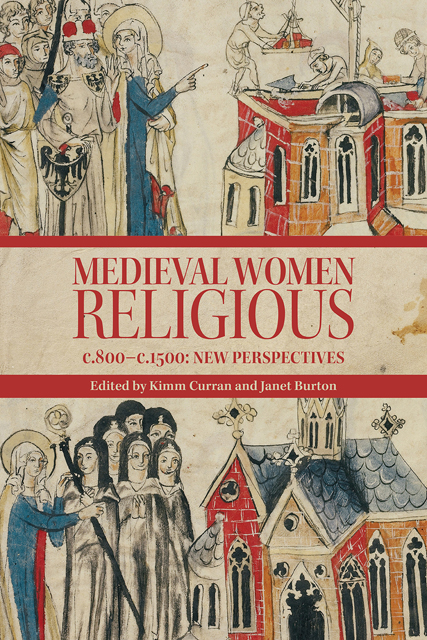Book contents
- Frontmatter
- Contents
- Illustrations
- Contributors
- Preface
- Abbreviations
- Introduction
- 1 Reform, Change, and Renewal: Women Religious in the Central Middle Ages, 800–1050
- 2 New Movements of the Twelfth Century: Diversity, Belonging, and Order(s)
- 3 Change and Renewal: Mendicants and Tertiaries in Later Medieval Europe
- 4 On the Fringes: Anchorites
- 5 ‘Quasi-religious’: Vowesses
- 6 Authority and Agency: Women as Heads of Religious Houses
- 7 Women Religious, Secular Households: The Outside World and Crossing Boundaries in the Later Middle Ages
- 8 Literacies, Learning, and Communal Reform: The Case of Alijt Bake
- 9 Family and Friends: Gift-giving, Books, and Book Inscriptions in Women’s Religious Communities
- 10 Communities of Medieval Religious Women and Their Landscapes
- 11 Materiality and Archaeology of Women Religious
- 12 Between Collective Memory and Individual Remembrance in Women’s Religious Communities
- Select Bibliography
- Index
- Miscellaneous Endmatter
10 - Communities of Medieval Religious Women and Their Landscapes
Published online by Cambridge University Press: 08 June 2023
- Frontmatter
- Contents
- Illustrations
- Contributors
- Preface
- Abbreviations
- Introduction
- 1 Reform, Change, and Renewal: Women Religious in the Central Middle Ages, 800–1050
- 2 New Movements of the Twelfth Century: Diversity, Belonging, and Order(s)
- 3 Change and Renewal: Mendicants and Tertiaries in Later Medieval Europe
- 4 On the Fringes: Anchorites
- 5 ‘Quasi-religious’: Vowesses
- 6 Authority and Agency: Women as Heads of Religious Houses
- 7 Women Religious, Secular Households: The Outside World and Crossing Boundaries in the Later Middle Ages
- 8 Literacies, Learning, and Communal Reform: The Case of Alijt Bake
- 9 Family and Friends: Gift-giving, Books, and Book Inscriptions in Women’s Religious Communities
- 10 Communities of Medieval Religious Women and Their Landscapes
- 11 Materiality and Archaeology of Women Religious
- 12 Between Collective Memory and Individual Remembrance in Women’s Religious Communities
- Select Bibliography
- Index
- Miscellaneous Endmatter
Summary
Women religious were embedded in the landscapes of the Middle Ages, and studying how they engaged with those landscapes – through agricul¬tural practices, building projects, and more – can help us better understand their impact on the world around them. Historians of landscape define their object of study in various different ways, but the study of the historical landscape generally involves the study of the interactions of geology, topography, cultural identities, and human activities layered together in a given place over time. At first glance, it might not seem as if the study of the historical landscape could have much to tell us about the history of women religious, and vice versa. After all, most women religious in the Middle Ages would have spent much of their lives behind the walls of their cloister, many communities of women religious had fewer financial resources than did their male counterparts, and women generally were at a legal disadvantage compared to men. How, then, could women religious influence the landscape? Adopting a landscape approach to the study of women religious helps us answer this question and prompts us to ask others. What kinds of relationships existed between women religious and the natural world in the Middle Ages? How did women religious manage both their resources and their relationships with the outside world? Were there differences between women religious and male reli¬gious in their use of the landscape?
This chapter focuses on how women religious helped to shape the landscapes they inhabited. First, it discusses the location of women's religious communities and the symbolic associations attached to those locations. Second, it considers the ‘inter¬nal landscape’ or layout of those communities, and how women religious organised the spaces in which they lived. It then turns to exploring the wider monastic estate – farmlands, water resources, woodlands, and more – and how women religious dealt with the challenges and disputes that arose from the landscape. Finally, it considers some of the legacies of monastic communities on the modern landscape and how new technologies can help us better to understand these places.
Locating Women's Monastic Communities within Sacred Landscapes
A particular place or landscape can have religious and affective meanings that are not purely topographical, but rather perpetuated through narratives as well as being framed by natural and built landmarks.
- Type
- Chapter
- Information
- Medieval Women Religious, c.800-c.1500New Perspectives, pp. 166 - 181Publisher: Boydell & BrewerPrint publication year: 2023

